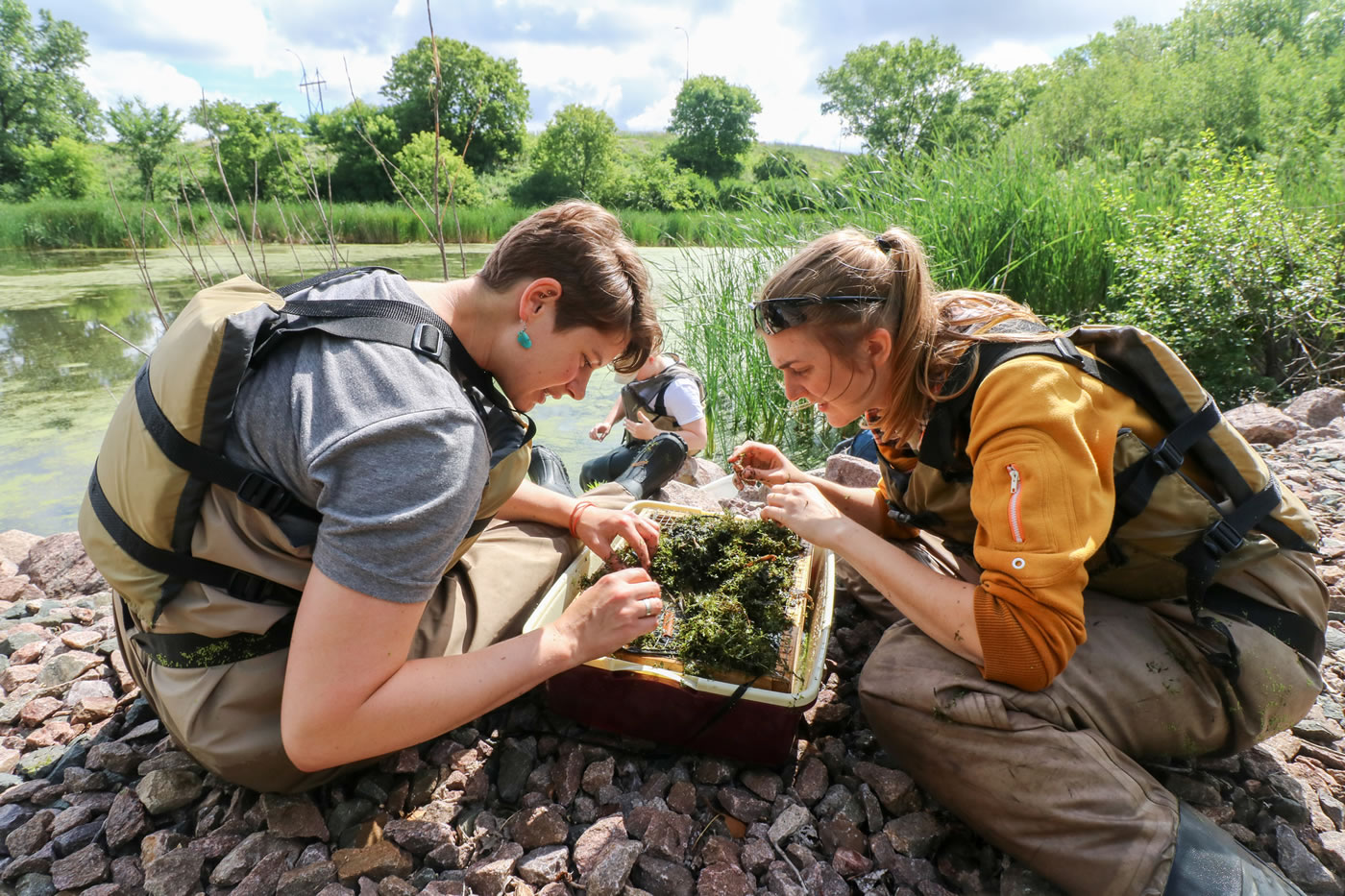The MWMO has routinely monitored three locations in the Kasota Ponds wetlands for water quality conditions since 2008. Prior to 2012, six additional sites had been monitored; however, an analysis of the data showed that three locations were sufficient to characterize water quality within the ponds. With nearly a decade of baseline water quality data collected, beginning in 2018, monthly water quality monitoring will now be conducted every five years. The MWMO also conducts biological monitoring in the three wetlands on a five-year schedule. Biological data were collected in 2011, 2016, and 2021.
Kasota Ponds Wetlands: Summary of MWMO Monitoring Activities 2008–2017 (PDF, 4.6 MB, 52 pages)
Wetland Water Quality Monitoring
Methodology
Sample Collection, Handling, and Preservation
Grab samples are collected once a month from three locations in the Kasota Ponds wetlands throughout the year, as conditions allow. Collection occurs away from shore, in about 3 feet of water and in approximately the same locations each time. Samples are collected in laboratory-cleansed (non-sterile) plastic bottles, at 1 foot below the water surface. Dissolved oxygen, conductivity, salinity, water temperature and pH data for each site is collected by placing a multimeter sonde approximately 1 foot below the water surface. Transparency is measured using a 100cm Secchi tube. When ice is present, staff conduct sampling activities by drilling a hole in the ice with an ice auger and use a capped, 3-inch diameter PVC tube to collect the samples.
Sampling Quality Control
Blank samples of DI water are regularly submitted to the laboratory to verify that sample containers are clean and samples are not contaminated during travel. In addition, 10 percent of all samples are collected in duplicate to verify that sampling and laboratory procedures do not introduce error in the data.
Laboratory Analyses
Samples are analyzed at the Metropolitan Council Environmental Services Laboratory. The laboratory follows strict protocols for quality assurance and quality control. Information regarding laboratory protocol is available from MWMO staff. Refer to Table A.1 in Appendix A in our annual monitoring report (PDF) for a list of the laboratories used for analysis, the analysis methods and information regarding certification.
Water Quality Monitoring Results
MWMO monitors the Kasota Ponds to characterize water quality in its wetlands. Samples are collected for nutrients, sediment, inorganics, and metals analyses. The MPCA water quality criteria indicate that wetland water quality should maintain background conditions. Kasota Ponds water quality data are available upon request and have been submitted to the MPCA EQuIS database.
2021 Kasota Ponds Water Quality Data (PDF, 4 pages, 0.7 MB)
Kasota Ponds Biological Monitoring
In 2011, monitoring at the Kasota Ponds wetlands was expanded beyond water quality to include assessment of the biological health of the wetlands. Results from the 2011 biological surveys can be found in the 2011 MWMO Annual Monitoring Report (PDF). With the goal of maintaining a five-year schedule for biological assessment, the monitoring was repeated in 2016. During June and July, the Kasota Ponds wetlands were sampled for macroinvertebrate and aquatic plant assemblages. These data were used to assess the health of the Kasota Ponds wetlands relative to other wetlands in the state and to establish baseline records for the wetlands. Results from the 2016 biological sampling can be found in the 2016 MWMO Annual Monitoring Report (PDF).
2021 Kasota Ponds Biological Monitoring Summary (PDF, 8 pages, 1 MB)

Wetland Macroinvertebrate Sampling
Sample Collection, Handling and Preservation Methods
Macroinvertebrate samples are typically collected in June every five years by following the MPCA’s Macroinvertebrate Community Sampling Protocol for Depressional Wetland Monitoring Sites (PDF). At each of the three wetlands, two samples are collected from the water column and vegetation above the substrate using dipnets. During the 2011 biological sampling, activity traps were also deployed. In 2016, activity traps were not used, per new MPCA guidelines. The MPCA reviewed activity trap use in wetland macroinvertebrate sampling and determined that it required significant staff time relative to its contribution to the Indexes of Biological Integrity (IBI) score calculation and also had the potential to cause fatalities of non-targeted species such as tadpoles and minnows (Bouchard, Chirhart, and Genet, 2011).
Sample Processing and Data Analysis
After sampling, macroinvertebrates are preserved in 95 percent ethyl alcohol. Macroinvertebrates are later identified to the genus or family level by staff a consulting firm. An IBI score is calculated for each wetland using methods described in Indexes of Biological Integrity for Large Depressional Wetlands in Minnesota (PDF).
Due to the omission of activity traps which target specific groups of macroinvertebrates, the number of metrics used to calculate macroinvertebrate IBI scores has decreased from nine metrics to the following five metrics: Leech Taxa, Odonata (Dragonfly/Damselfly) taxa, ETSD Taxa (genera of mayflies, caddisflies, fingernail claims, dragonflies), Snail Taxa and Total Taxa. Therefore, the range of possible IBI scores shifted from 9–45 in 2011 to 5–25 in 2016.
Aquatic Plant Surveys
Survey Methods
Aquatic plants are surveyed using the relevé sampling method, following the MPCA’s Aquatic Plant Community Sampling Procedure for Depressional Wetland Monitoring Sites (PDF). Relevé surveying involves the selection of a 100 square meter plot that contains a representative portion of the entire wetland’s vegetation, including emergent and submerged vegetation, when applicable. Surveyors then identify all of the species within the plot and estimate the percentage of the plot covered by each species. Aquatic plant surveys are typically conducted in July every five years and an IBI score is calculated by MWMO staff for each wetland, following methods described in Indexes of Biological Integrity for Large Depressional Wetlands in Minnesota (PDF).